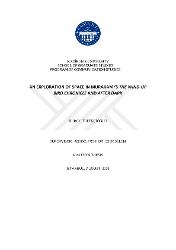| dc.contributor.author | Tüfekçioğlu, Burcu | |
| dc.contributor.author | Selen, Eser | |
| dc.date.accessioned | 2021-08-10T14:18:59Z | |
| dc.date.available | 2021-08-10T14:18:59Z | |
| dc.date.issued | 2019 | |
| dc.identifier.uri | https://hdl.handle.net/20.500.12469/4243 | |
| dc.description.abstract | Bu çalışma, Haruki Murakami'nin iki farklı eserinin yakın okumasını yaparak, eserlerdeki mekânlar ve karakterler arasındaki ilişkiyi ve bu karşılıklı ilişkili olma durumunun önemini ortaya koymak amacıyla sunulmuştur. Zemberek Kuşunun Güncesi (1994-95) ve Karanlıktan Sonra (2004) adlı romanlar arasındaki benzerlikler bu amaç doğrultusunda incelenmiştir. Bu tezde Henri Lefebvre'nin mekân teorisi üzerinden eserlerdeki mekânların ve karakterlerin birbirlerini nasıl eş zamanlı olarak ürettikleri karşılaştırmalı bir biçimde ele alınmaktadır. Yıllar boyunca, Murakami kitaplarının kendine özgü bir dünyaya sahip olduğu iddia edilmiştir. Bu çalışmada, kitaplardaki karakterlerin ve mekânların birbirleri sayesinde nasıl kendilerini var ettikleri açıklanmaktadır. Karakterlerin ortaya çıkması için mekânın zorunlu olduğunu öne sürmekle birlikte, çalışma, aynı şekilde karakterlerin de mekânın üretilmesi için zorunlu olduğunu savunuyor. Araştırmadan beklenen sonuç, her iki romandaki mekânlar ve karakterler arasında etkileşimin benzeşen yönlerini ortaya çıkarmaktır. | en_US |
| dc.description.abstract | In this study, a close reading of two literary works by Haruki Murakami is presented in an attempt to reveal the relationship between spaces and characters. Both The Wind-Up Bird Chronicle (1994-95) and After Dark (2004) demonstrate similar stylistic patterns and features. Embarked from Henri Lefebvre's discussion on how space is socially produced by human beings, this study undertakes a comparison between both novels to reveal how Murakami's characters produce different levels of space while simultaneously being transformed within and through them. Murakami's novels have long been argued to have a world of their own unique nature. In order to discover the components of Murakami's fictional world, a more thorough view on his two prominent novels namely, The Wind-Up Bird Chronicle and After Dark, will be conducted. The aim of this study is to underscore how characters of Haruki Murakami are comprised of their experiences within and through space. While suggesting that space is a requisite as a medium for characters to come into existence, the study, conversely, argues that characters, too, are instruments for substantiation of the production of space. The expected outcome from the research is to find analogical aspects of the interaction between spaces and characters in both novels. | en_US |
| dc.language.iso | tur | en_US |
| dc.publisher | Kadir Has Üniversitesi | en_US |
| dc.rights | info:eu-repo/semantics/openAccess | en_US |
| dc.subject | N/A | en_US |
| dc.title | An exploration of space in Murakami's the Wind-up bird Chronicle and after Dark | en_US |
| dc.title.alternative | Murakami'nin Zemberekkuşu'nun Güncesi ve Karanlıktan Sonra adlı eserlerindeki mekânların incelenmesi | en_US |
| dc.type | masterThesis | en_US |
| dc.department | Enstitüler, Lisansüstü Eğitim Enstitüsü, İletişim Bilimleri Ana Bilim Dalı | en_US |
| dc.institutionauthor | Tüfekçioğlu, Burcu | en_US |
| dc.institutionauthor | Selen, Eser | en_US |
| dc.relation.publicationcategory | Tez | en_US |
| dc.identifier.yoktezid | 612906 | en_US |
















